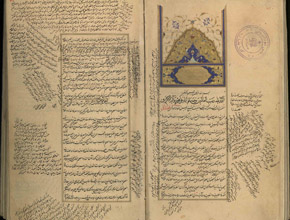Introduction
Scientific Motivations

Beginning of Ilāhiyyāt
Ms. Tehran, Kitābḫānah-i Maǧlis-i Shūrā-yi Millī (now: Kitābḫānah-i Maǧlis-i Shūrā-yi Islāmī = Parliament Library), 10198
An accurate knowledge of the Ilahiyyat of Avicenna’s Kitab al-Shifa’ is a major desideratum in many different respects. This concerns, first of all, Avicennian scholarship, since the Shifa’ is the most important philosophical summa by Avicenna, and its metaphysical section, the Ilahiyyat, represents the doctrinal core of this work. By being the culmination of theoretical philosophy, after logic, natural philosophy and mathematics, the Ilahiyyat is the point of intersection, on the one hand, of philosophy with revealed theology – in so far as metaphysics is the discipline charged with proving God’s existence and clarifying His nature and activity – and, on the other hand, of theoretical speculation with practical philosophy – in as much as the metaphysical treatment of prophecy serves as the foundation and regulation of personal, familiar and civil life. Thus, a better knowledge of the Ilahiyyat will allow a more accurate assessment of Avicenna’s metaphysical doctrines themselves, as well as of their interrelations with other disciplines of Avicenna’s philosophy; of Avicenna’s position with respect to revealed theology; and of the development of his thought and the chronology of his writings.
But this applies also to the research on Arabic philosophy and Islamic civilization in general, since Avicenna is one of the greatest philosophers of Islam, and his thought was deeply rooted in the previous philosophical tradition, both Greek and Arabic, and strongly influential on later philosophy, theology, and science. In this regard it is not exaggerate to regard Avicenna as the “second Aristotle”, and the Ilahiyyat as the “second beginning” of metaphysics and philosophical theology in the history of philosophy. The need of a more precise acquaintance with the Ilahiyyat is thus very much felt also in the larger field of Arabic philosophy and culture. The current trend in this field is to focus on post-Avicennian thought, examining its philosophical, theological and scientific aspects: any study in this area will crucially depend on a reliable edition and philosophical explanation of the authoritative text of this tradition.
The aforementioned necessity regards, finally, the study of the process of interaction and dialogue among different disciplines, cultures, and religions that took place in medieval history. Arabic metaphysics in general, and Avicenna’s metaphysics in particular, is the intellectual field in which the Greek philosophical heritage (Aristotle) most deeply entered into contact with a monotheistic creed (Islam), thus creating a synthesis between philosophical and scriptural theology that was extremely appealing to philosophers and religious thinkers not only of the Muslim world, but also of Christianity and Judaism. The wide and lasting impact of the Ilahiyyat on the metaphysics of thinkers belonging to the three monotheistic religions, and their related cultures, is a very significant phenomenon that needs to be studied comparatively.
Philosophy on the Border of Civilizations and Intellectual Endeavours:
Towards a Critical Edition of the Metaphysics (Ilâhiyyât of Kitâb al-Šifâʾ) of Avicenna (Ibn Sînâ)
ERC Advanced Grant 339621
Scuola Normale Superiore, Pisa, Italy
Piazza dei Cavalieri, n. 7
IMT School for Advanced Studies, Lucca, Italy
Piazza S. Ponziano, n. 6
Mail: info@avicennaproject.eu



